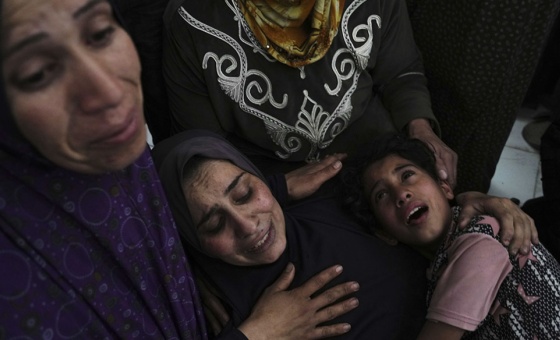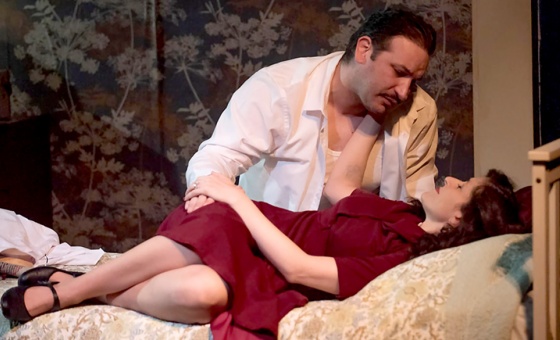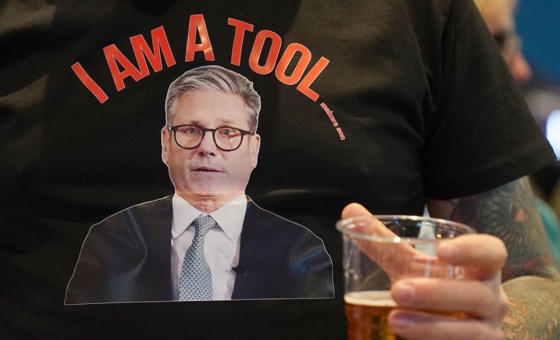This is the last article you can read this month
You can read more article this month
You can read more articles this month
Sorry your limit is up for this month
Reset on:
Please help support the Morning Star by subscribing here
WHEN Daniela Abraham was a little girl in Slovakia in the 1980s her mother asked her why she was spending so much time scrubbing herself in the bath tub. “Because they told me I was a dirty Gypsy,” she told her mother.
Daniela is Roma. Her persecution in Slovakia began even before primary school — at nursery level: tiny tots refusing to play with her, being bullied, being called a “cigany,” meaning thief, criminal, liar.
Today Abraham, 39, lives in London, where she recently organised the first-ever collective Roma protest against Slovakian neonazis when they visited the capital to try to rally Slovakians living in Britain to their cause.
She uses her mother’s maiden name, rather than her family name, because she still has relatives living in Slovakia, where the rise of the far right is leading to even worse persecution of Roma than existed during her childhood.
In Britain she is also involved in the Sinti Roma Holocaust Memorial Trust. At least 750,000 Roma and Sinti people died in the Holocaust. More recent research says the number is more likely to have been twice that. Much of the slaughter took place after the nazis invaded Hungary in 1944. Members of Abraham’s family were among the victims.
Today’s rising Slovakian neonazis — the LSNS, the Our Slovakia Peoples Party — deny the Holocaust ever happened.
Abraham’s early story is one of thousands being repeated today in Slovakia and elsewhere in eastern Europe.
Her schooldays were not happy.
“From childhood it starts, almost from nursery. You get the bullies. You don’t understand why this is happening. The children don’t want to play with you. Calling you cigany. Being called that from when you are five or six years old affects your childhood.
“They call you ‘dirty Gypsy.’ They ask ‘why are you brown? You’re dirty.’ I remember as a child I would stay in the bath for hours trying to wash it off. My mother explained that I could not wash it off because this is our colour.
“I asked her ‘why am I this colour? I’m not dirty.’
“Even if I wore nice clothes, had a nice satchel, always they bullied me in school, didn’t want to play with me. I felt I wasn’t part of the collective.”
The teachers were no better. She continually found herself being given low grades despite her excellent work.
“I thought, ‘why are they doing this to me?’ Now I know. They were being racist. There was nothing wrong with me. It was what was wrong with them.”
One of the worst incidents happened when she was 10. She was walking home with her little brother when a neighbour shot her in the chest with a birdgun — a shotgun.
The day before he had shouted at her: “I’ll shoot you, you dirty Gypsy.”
“I still have the marks,” she said. “For months I was scared to go out.
The persecution continued into adulthood.
“In Slovakia I had massive difficulties finding a job,” she said. I speak several languages but it was very difficult for me to find work and support the family because of racism. Slovakia is so racist.
“This is why I was worried for my family, my children. I thought ‘I don’t want to give them this kind of life, this whole struggle.’ That’s why I came to the UK.”
Her husband — now her ex-husband — came to Britain, and she followed in 2007 with their sons. In Britain she became involved in the Sinti Roma Holocaust Memorial Trust.
“It was because my family was murdered. I don’t know exactly how many because my family was large.”
She lives in east London, doing a variety of jobs, including on a community project. Among the languages she speaks are Hungarian, Slovakian, Czech, German, Romanian and English.
A short time ago she discovered on Facebook that Slovakian neonazi LSNS organisers were coming to London to spread their hate among the capital’s Slovakian community. The visit was to involve a Euro-MP and a national MP from the neonazi LSNS.
“They openly made an event saying they were going to come here with their political campaign and have discussions at a meeting at the Barbican,” she said.
“I thought, ‘why come here, to a country that is multicultural? Why are you coming here? For what?’ It gave me a big question mark.
“It’s estimated that there are 300,000 Roma here in the UK. It felt like a message to us. Us Roma, we left Slovakia because of the anger, the racism in the country, the harassment, racist speech, racial abuse. We left because of the racism. We couldn’t understand why these people were coming here. So I felt a responsibility to take some action.
“I have to mention that the biggest reason I wanted to do something, a demonstration, was because these people deny the Holocaust. These people call our people parasites, that we are a threat, that we are criminals. The leaders of these people call our children animals. I felt a responsibility that I had to do something about it.”
She could not act alone. Through a contact she reached Unite Against Fascism (UAF) and Stand Up to Racism (SUTR).
Activists monitored the LSNS Facebook and websites, identifying first one London venue where they planned to stage their meeting, then contacting the proprietor, and then a second venue. Both venues cancelled.
Two days before the planned meeting the LSNS MP and Euro-MP pulled out of the visit as news of the coming protest spread. Finally the LSNS decided to meet at the Shakespeare pub at the Barbican.
A dozen of them arrived, only to be faced with between 100 and 200 anti-fascists. But the biggest single mobilisation was from the Roma people themselves. Roma from Yorkshire, Derbyshire, Dover and London responded to the call to mobilise.
“The Roma came together, with other anti-fascist groups, for the first time,” said Abraham. “From the Roma there were 105 people. It was great to see this. There are Roma in Derbyshire, in Sheffield, some of them working in fields. They work all weekend. That Saturday they took the day off and came to London.
“This is the first time we have done something like that, where we got united and came together with other anti-fascist groups. I felt it was a victory. I was happy.”
The Roma carried a flag which was designed at a Romany gathering in London in 1971 with the help of a visiting official from India. It bears the Chakra, a 24-spoked wheel, which is also the main feature of the flag of India.
“It’s because originally we are all from India,” she said. “It symbolises that we are travelling, but that we are originally from India. We are many tribes from different parts of the world, but we are from India. In Europe the majority are Roma, Sinti, Lovara.”
The dozen Slovakian neonazis in London were stunned to see Roma people protesting, defying them.
“In Slovakia they’re used to doing what they want to us.”
Police intervened, and the neonazis were escorted away.
She said the key to the new defiance was not just the first-time mobilisation in Britain of Roma people against the neonazis — in itself a ground-breaking event — but their unity with other groups.
“I want to thank them because they joined us, anti-fascist groups and students from Slovakia, and especially UAF. They supported me in this. I felt very happy that I was not doing this myself because I had the support of these people.”











